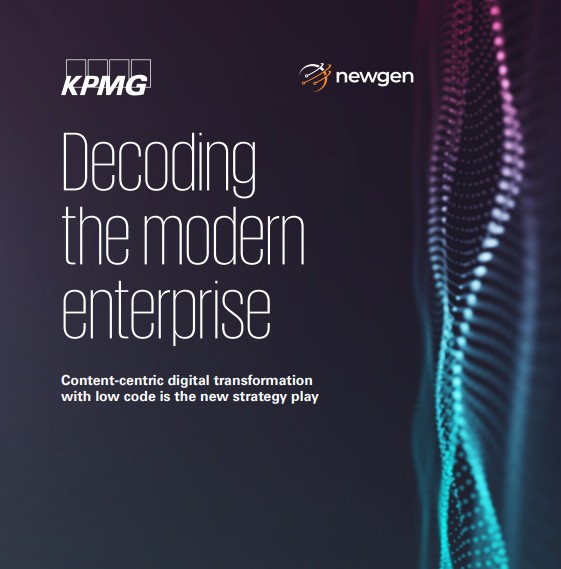The New Face of Enterprise Transformation
“The new normal is disruption.”
That’s how Gartner’s CIO Agenda Report defines today’s business landscape — one where agility and innovation are no longer optional but essential. The modern enterprise must continually evolve to meet rising expectations across users, employees, and partners, while ensuring operational excellence and superior customer experience.
Digital transformation has been underway for years, but most organizations still struggle to keep pace with the speed and complexity of change. Factors such as information silos, lack of contextual engagement, and over-reliance on IT continue to delay progress.
To thrive in this environment, enterprises must reimagine transformation by uniting two powerful enablers — content and low-code platforms.
The Modern Enterprise Challenge
Even after years of investment in automation, enterprises face three persistent hurdles:
- Lack of Contextual Engagement
Omnichannel initiatives often fall short because internal systems fail to share context. As a result, customer interactions remain disjointed and inconsistent. - Information Silos
Departments operate like isolated towers, with fragmented processes and data, preventing a unified view of the customer or operation. - High IT Dependency
Gartner predicts that demand for app development will grow five times faster than IT’s ability to deliver. This limits innovation and delays transformation.
These obstacles prevent enterprises from delivering the seamless, real-time experiences their customers and partners expect.
Content as the Foundation of Digital Transformation
Content is at the heart of every interaction, process, and decision. Yet, most enterprises fail to manage and utilize it effectively. IDC predicts that 80 percent of enterprise data will be unstructured by 2025, spanning documents, videos, emails, and social media posts.
Without the ability to process and act on this data, enterprises lose valuable insights and efficiency.
Imagine a small business applying for a loan online. They submit identity documents, collateral proofs, and financial statements — all in different formats. A modern, content-driven system can capture, analyze, and validate this information in real time, completing the process without human intervention.
From instant insurance claims processing to digital KYC verification, contextual content is the driving force behind seamless customer experiences.
The Strategic Play: Content Meets Low Code
Modern enterprises are built around two pillars — context and speed.
To achieve both, organizations need a strategy that integrates content intelligence with rapid application development, powered by low-code platforms.
This combined approach drives four key outcomes:
- Future-Ready Digital Workplaces
Employees, partners, and customers can access services and collaborate in real time from any channel. Intelligent automation ensures end-to-end process visibility and faster decisions.
- Contextual Customer Experiences
Content management platforms deliver “contextual automation,” enabling employees and systems to act with full understanding of customer history and intent.
- Content Intelligence and Analytics
AI and machine learning transform unstructured content into insights, allowing enterprises to offer products like real-time loan approvals, instant insurance issuance, and smart claims disbursal.
- Regulatory Compliance and Security
A robust content management framework provides controlled access, audit trails, and lifecycle management for all digital assets — ensuring transparency and compliance.
The Role of Low Code in Building the Modern Enterprise
To execute this strategy, organizations need a low-code digital transformation platform — one that connects content, processes, and communication into a single framework.
What a Low-Code Platform Enables
- End-to-End Automation
Unify process automation, content services, and omnichannel engagement to deliver cohesive experiences. - Agile Development
Build and modify business applications quickly using visual tools and model-driven design. - Intelligent Operations
Integrate AI, ML, RPA, and content analytics to drive smarter, faster decision-making. - Seamless Collaboration
Enable real-time interaction among employees, customers, and partners. - Central Governance and Security
Maintain visibility and compliance while reducing shadow IT risks. - Cloud-Native Scalability
Support hybrid deployments and ensure flexibility for future expansion.
Low-code platforms empower enterprises to innovate rapidly, respond to market conditions, and deliver measurable outcomes — without overburdening IT teams.
Making the Modern Enterprise a Reality
Digital transformation is a journey, not a one-time project. To become a truly modern enterprise, organizations must follow a structured approach:
- Assess the Current State
Identify processes that directly impact customer experience and can benefit from content-driven automation. - Establish a Low-Code Platform
Begin with three to five key business processes that can deliver quick wins. - Deliver Incremental Value
Build confidence through agile development and iterative success stories. - Scale Gradually
Extend low-code adoption across departments, integrating complex workflows and multi-stakeholder processes. - Build Continuously
Foster a culture of innovation and continuous improvement powered by low-code agility and content intelligence.
By starting small and scaling strategically, enterprises can transform into agile, connected ecosystems capable of constant innovation.
Why Content and Low Code Are the Future of Enterprise Strategy?
The convergence of content-centric automation and low-code development offers unmatched advantages:
- Faster time to market
- Enhanced operational agility
- Improved customer experience through contextual engagement
- Reduced compliance risk
- Better collaboration across distributed teams
This dual approach ensures enterprises can handle increasing complexity while remaining flexible, responsive, and cost-efficient.
The Newgen Advantage
Newgen’s low-code digital transformation platform empowers enterprises to connect processes, data, and content seamlessly.
Key Benefits
- Unified platform integrating process automation, content services, and communication management.
- Rapid application development with built-in governance and compliance controls.
- Scalable, hybrid cloud architecture for enterprise-grade resilience.
- AI-driven content intelligence and analytics.
- Proven success across industries, from banking and insurance to government and manufacturing.
Through its NewgenONE platform, Newgen helps organizations build future-ready digital enterprises — enabling faster innovation, contextual engagement, and operational agility.
Conclusion
A modern enterprise thrives on speed, intelligence, and connection. To sustain growth and innovation in an unpredictable digital world, businesses must reimagine transformation through the lens of content and low code.
The partnership of KPMG and Newgen demonstrates how enterprises can decode this complexity, enabling organizations to achieve:
- Connected processes
- Context-driven decisions
- Continuous innovation
Transformation is no longer about technology adoption — it’s about building a resilient, intelligent enterprise that evolves effortlessly with change.

